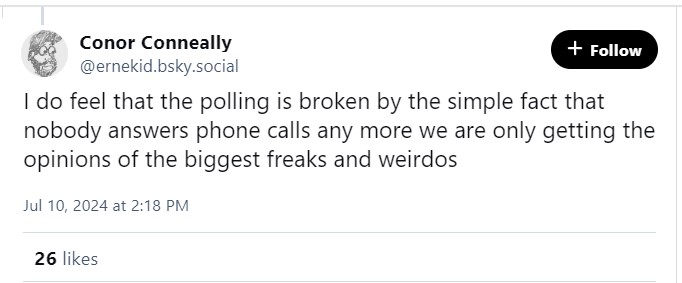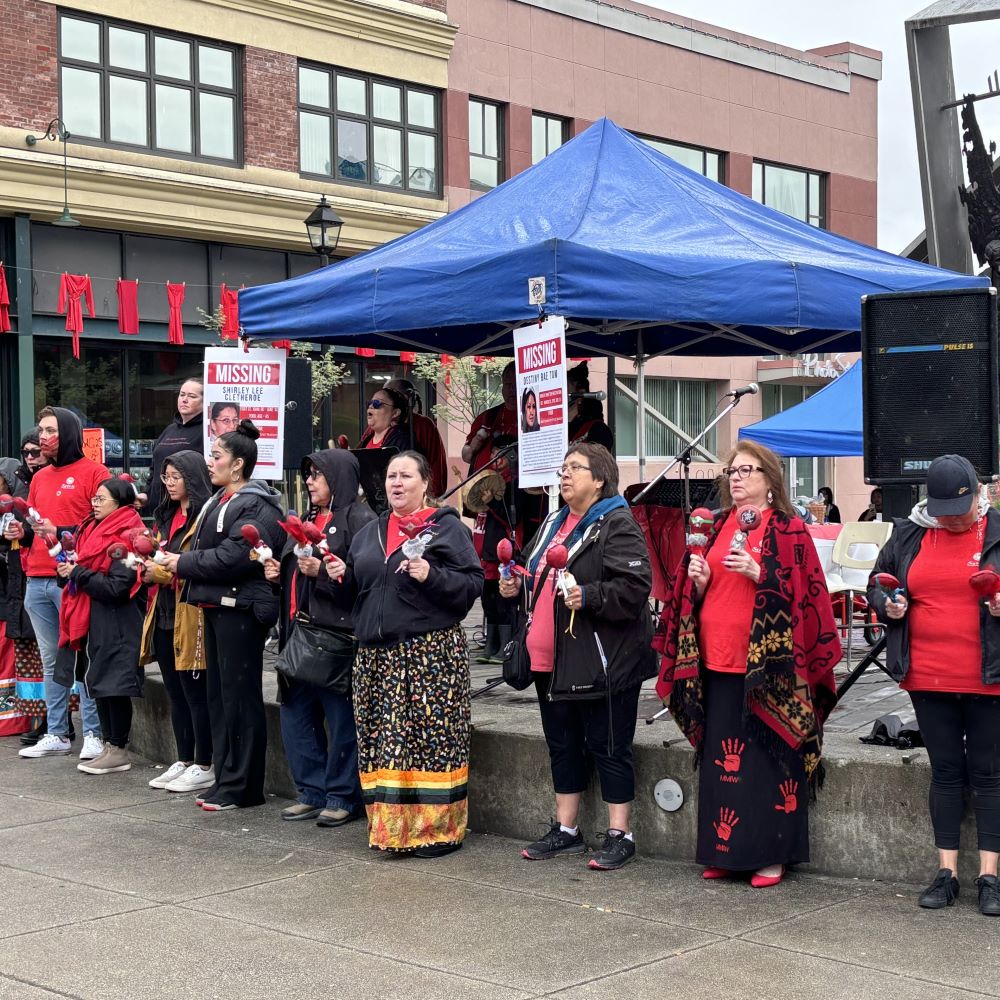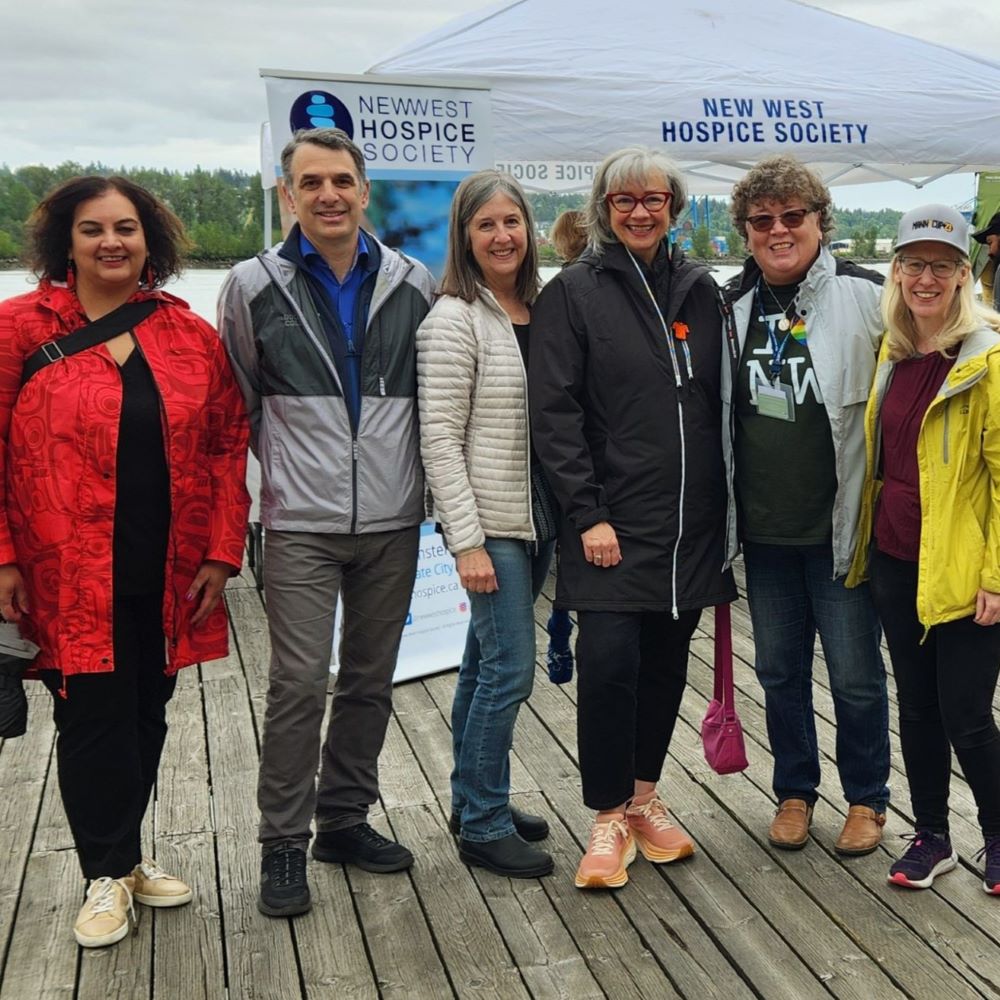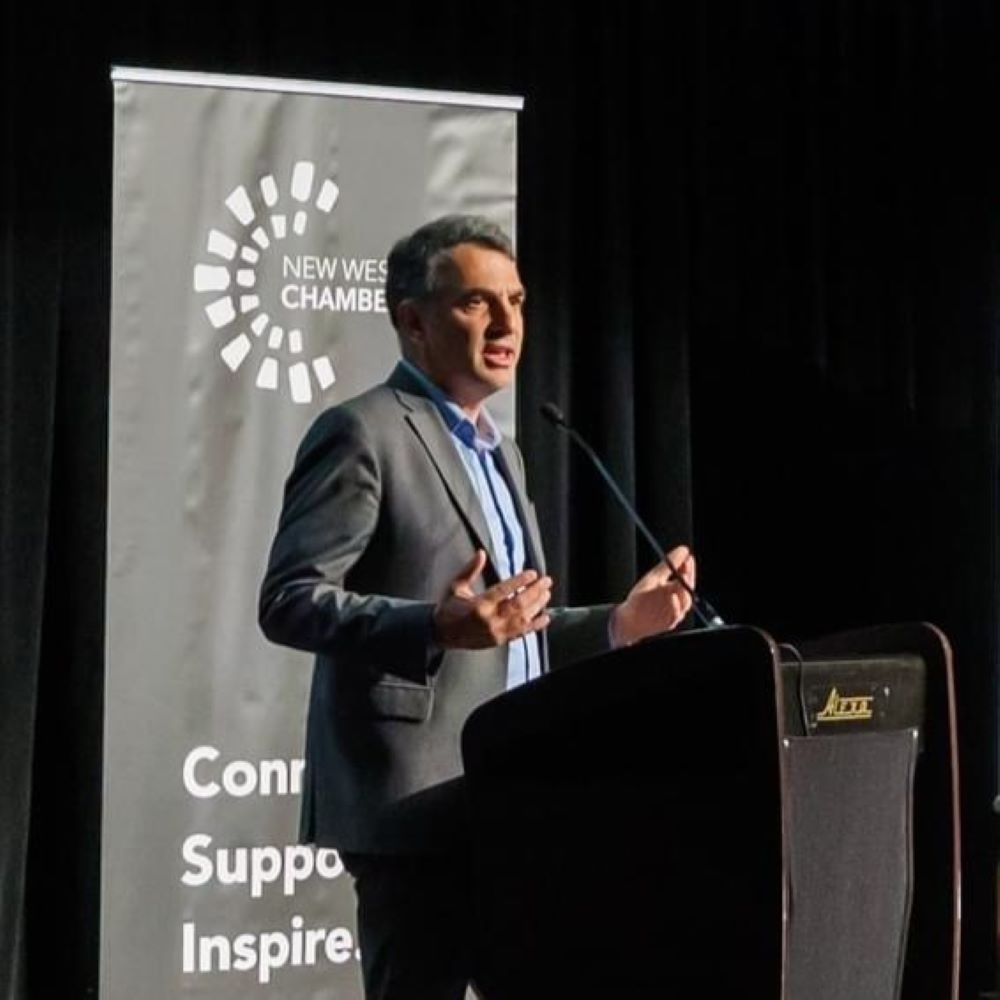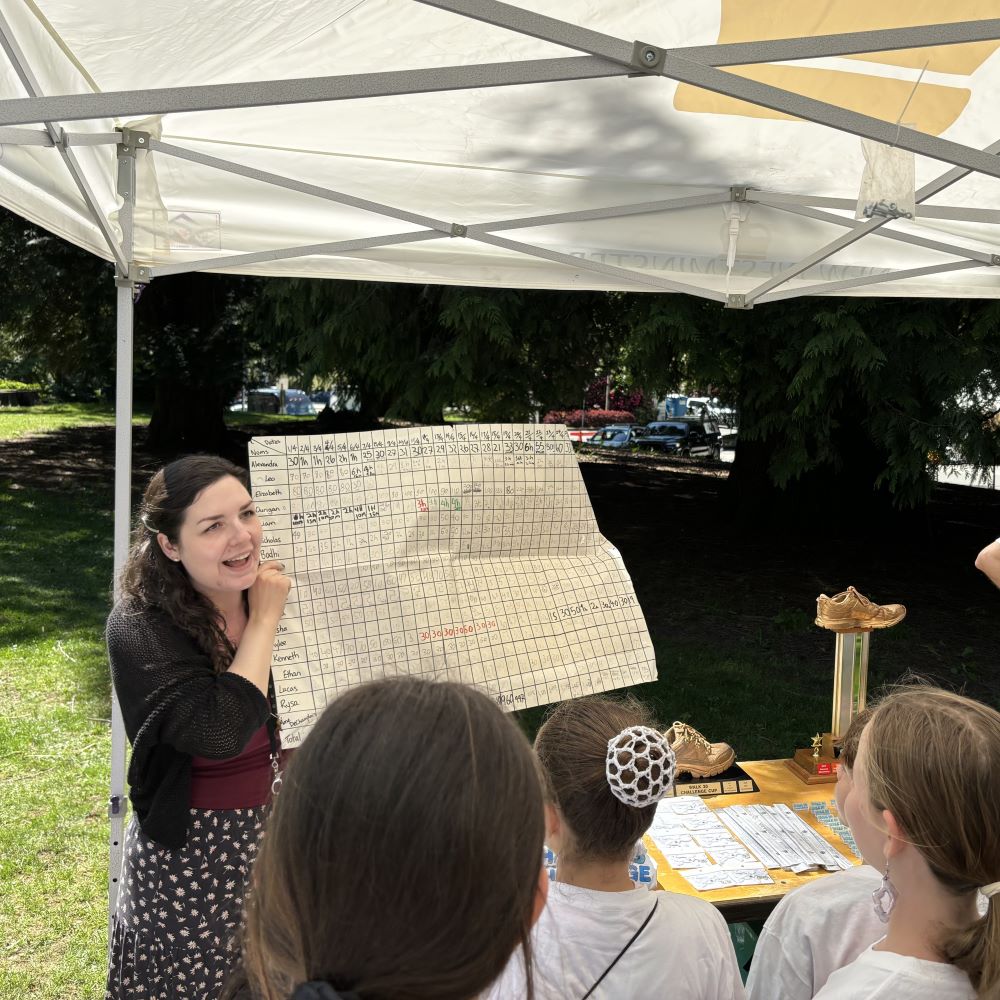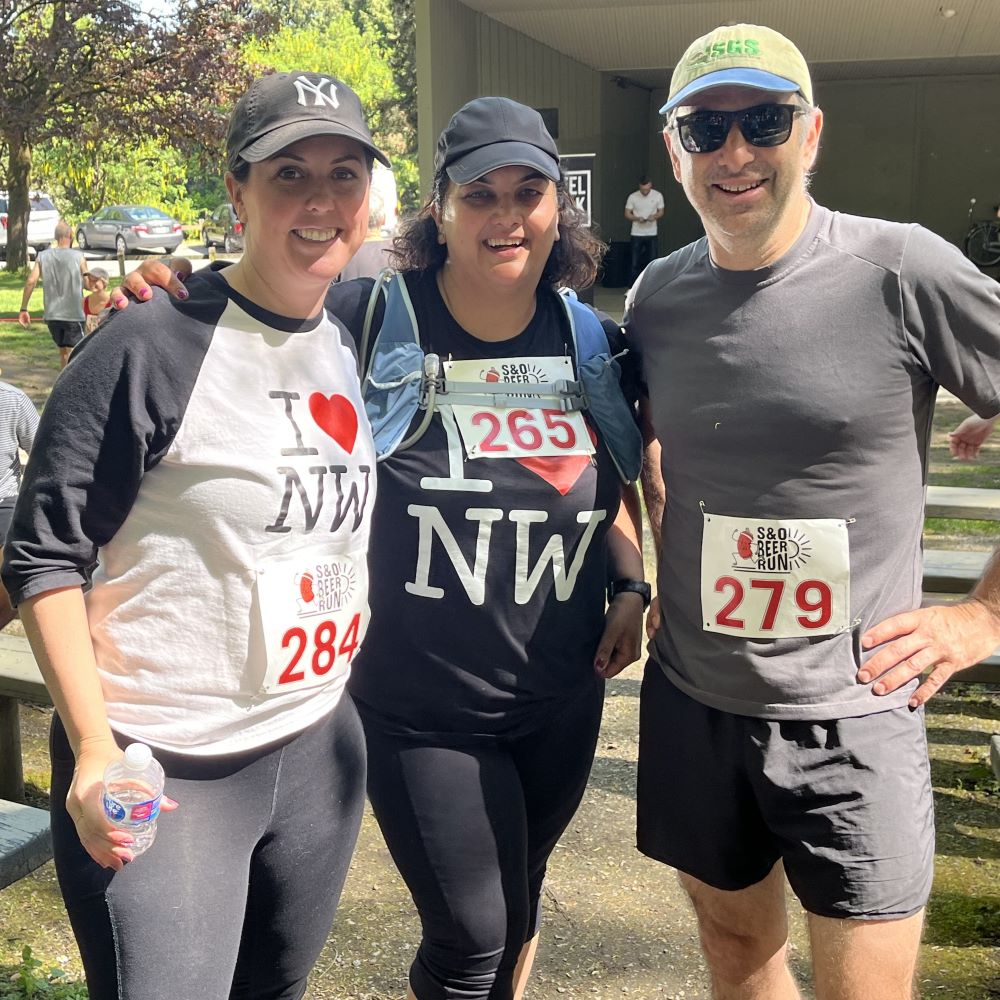It was a bit of a marathon day for Council on Monday, as isn’t uncommon as we try to get things done before the summer break. Its a long one, but trust me there’s some juice down there for those willing to scroll! We had a busy afternoon workshop with lots of items – so much so that I might break tradition here and post about a workshop in a follow-up, but first let’s try to get through the evening agenda!
We started the meeting with a Public Hearing:
Official Community Plan Amendment (801 Boyd Street) Bylaw No. 8448,2024
Zoning Amendment Bylaw (801 Boyd Street) No. 8449, 2024
The owner of Queensborough Landing wants to convert some unused buildings to self-storage, which is a slightly different land use designation, but different enough in class that it requires an OCP amendment to make happen, and therefore a Public Hearing. The request is to subdivide off the 1 acre corner of the much larger lot, and apply the OCP change to only that lot. OCP amendments are a bit of a complicated process, including significant consultation, which has been ongoing for more than a year now.
The New West Design Panel and Advisory Planning Commission approved the application. The Ministry of transportation expressed no concerns, and First Nations were consulted with no opposition to the application. The community meeting was not attended by anyone, and sparse feedback on the community survey had very low response, almost all negative. We received one piece of correspondence in favour of the application and had no-one present to the Public Hearing.
Council moved to approve third reading of both the OCP amendment and the rezoning.
We then had a Presentation from the CAO:
Presentation of the 2023 Annual Report
Unlike the Mayor’s State of the City Address, this is the *Official* annual report of the City. It is a summary of everything the City got done in the last year, and to me the best part is the numbers pages: 3,236 SeeClickFix requests responded to; 257 staff hired; 271,000 Library visits; 156,000 registered recreation participants; 240 Anvil Centre events; 3,890 Business licenses issued; 3% population increase; 600 large trees and 4,000 seedlings planted in City lands; 520 Street lights repaired; 64,000 QtoQ trips; it goes on and on, because there is a lot happening in the City every day. You can read the annual report HERE.
Council then moved the following items On Consent:
2024-2034 Canada Community- Building Fund Agreement
The City receives a little over $300,000 a year through the Canada Community-Building fund, and we need to sign an agreement with UBCM (who help administer the fund for the Feds and Province). This used to be called the Federal Gas Tax Fund, but has been rebranded as it isn’t really linked in any meaningful way to the gas taxes collected by the Federal government. We are a little limited on what we can spend it on (basically, infrastructure only), and will have that conversation during our budget deliberations. For now, we are signing the agreement to get the money.
Community Excellence In Service Delivery Award Application
We are applying for an award, in recognizing some great work our EMO is doing as a follow-up to coordination and communications challenges during the 2021 Heat Dome disaster. Cross your fingers!
Construction Noise Bylaw Exemption Request: 220 Salter Street (Metro Vancouver Sewer Inspection – Fraser River Crossing Project)
Its Sewer maintenance season, and some work needs to happen at night when sewer flows are low. Sorry, folks, but this should not really be very noisy work other than a few vehicles and generators running.
Construction Noise Bylaw Exemption Request: 252 Brunette Avenue (Sapperton SkyTrain Station)
There is going to be some upgrade work at Sapperton Station this summer, and some of that work has to happen when the trains are not running, which means night work.
New West Pride Municipally Significant Event Designation LCRB Resolution
At risk of repeating myself, I’m just going to quote my comments from a couple of weeks ago, with a few words changed: “Our provincial liquor licensing regulations are ridiculous and archaic, and everyone involved (manufacturers, retailers, events coordinators, even cities) are always trying to find a way through or around them to make things happen while keeping letter-of-the-law legal. For festivals, especially, this can be daunting. For a festival, not only does the Province regulate the size of a glass of beer or wine that can be served, they regulate a maximum price it can be sold at – a maximum price that has not been raised in 9 years. So if a festival wants to charge a little more and make a bit more money from alcohol sales to pay for other aspects of the festival (like hiring talent, security, advertising, etc.), they can’t do that. Unless they are designated a “Municipally Significant Event”, whatever that means. The request here is to designate Uptown Live PRIDE as “Municipally Significant” so they can charge a little more for beer to help offset the other costs of a free to the public festival.
Proposal to Change Liquor Licence for The Royal Canadian Legion Branch No.2
More on liquor laws, this one is a bit easier to understand. The Legion has a private club liquor license that requires guests to sign in, and wishes to shift to a regular liquor primary license. There are no issues identified with the change, and the City is endorsing this application that needs to go to the Province for approval.
Riparian Areas Protection Miscellaneous Amendment Bylaw No. 8468, 2024
These Bylaws are required to keep the City complaint with the Provincial Riparian Areas Protection Regulation and regulate how development happens in the riparian areas (upland dry areas where plants, shade, and slope provide ecological function to the stream) of streams and rivers in the city. We are updating them to address a typographic error in the earlier adopted versions. Because law.
The following items were then Removed from Consent for discussion:
2024 Capital and Operating Quarterly Performance Report
This is a regular update on our budget. No surprise to anyone dealing with capital projects right now, costs are going up, and some things we budgeted for in previous years are costing more to deliver in 2024 than we expected. However, the biggest change here (92% of the change) is carryforward adjustment for projects we simply didn’t get to completion in 2023. The money we didn’t spend in 2023 needs to be budgeted for in 2024, so we are therefore adjusting our $180.4M 5-year capital budget to $199.1M, though only $1.5M is an actual increase of overall costs. There are a few new capital item included in that $1.5M, like the need to reconfigure some City Hall spaces to deal with a space crunch ($250k), upgrades to the Columbia Station elevator to address chronic repair issues ($138k). One of the complications of Capital budgets is that we need to include things here that won’t cost the taxpayers anything, like a donation we received for the library to purchase an electric vehicle ($60K), upgrades to the QtoQ dock infrastructure to be paid by DAC funding form the province ($800K), and spending money to support development projects ($175K) that will ultimately be paid to us by the developer.
On the operating side, we are running a little ahead of forecast on both revenue and expenditure, with the combined variance leaning on the revenue side, which is good news. We are in good shape financially.
2024 Council Remuneration
Council gets paid. Our remuneration policy provides a cost-of-living increase every year, linked to CPI. This year, that means a 4% increase, which is essentially the same as the collective agreement the City has with union staff. This is policy driven, so Council doesn’t need to approve it. If they want to make changes, they need to change the policy.
It’s not a great system, elected people choosing their own salary, but it’s the system available to us under provincial regulation. Previous Council set up a process where changes to that policy be reviewed every term (so, every 4 years), to be implemented after the next election, so there is a bit of a political check-in around this policy before the elected receive any benefit of changes. We skipped the least review in 2022 because we were severely short-staffed in HR coming out of COVID, so we are overdue for a review. This report asks if Council wants to continue that practice – do a review before the next election to be applied after the election – or wants to follow a different path.
The big question Council needed to address – do we want to do the review now, recognizing that any change we implement won’t be applied until after the 2026 election, or have the review immediately before the election, which made me paraphrase Kim Campbell “an election is not time for serious public policy discussion”. Council agreed with the former Prime Minister, and agreed to start the review sooner
Bus Speed and Reliability Study
New West is a Transit City – likely the highest transit mode share of any municipality in BC. Alas, there is still too much through-traffic slowing the buses down, and TransLink has a region-wide program to boost “speed and reliability” of bus service through the region to make the system run smoother, and ultimately save the system money. They will cost share capital programs (up to 100%!) with the City to build infrastructure that improves BSR, and we have been successful in applications for BSR funds, so Staff are ready to get moving, because it will never be less expensive than now to do this work.
This report identifies 12 projects that can be implemented in the next 5 years to address bus delay hot spots. It is important to note many of these align with our Bold Step to re-allocate road space from car-primary use to sustainable transportation. It’s also the right thing to do, when Translink data shows 62% of the people travelling on Sixth Street during peak times (when there is congestion) are in a bus, and getting them out of the traffic of single passenger cars is a priority.
The majority supported moving this forward, though the two “progressive” members of council voted against it for unclear reasons, an indication of a trend on the night.
E Columbia Street/Brunette Avenue Road Safety Review
There has been a lot of engineering work looking at East Columbia by Cumberland for the last year. It’s a difficult spot that has been an uncomfortable bone of contention for active transportation users for a decade or longer, but with no easy answers because of a variety of engineering constraints.
One interesting aspect of why it took so long to do this analysis once Council asked for it last year, and it has to do with conflicting ideas about what the real safety challenge is here. Statistically, it is not an “unsafe” piece of sidewalk, and data would suggest the highest safety priority here is reducing risk of car-truck collisions. However, it definitely “feels” unsafe on that sidewalk, and that creates a barrier to use for many people. Engineering stats also have a hard time counting “near miss” data, which is typical of many safety system analyses, but lacking in most road safety planning. So staff did some work to collect “near miss” data in this area using video-based conflict analysis.
As suspected, there are some short-term measures we can take to make the space a little more comfortable for active transportation users, but it is not going to be the big solution that some folks would like to see. We don’t have the authority or permission to close the sidewalk-adjacent lane to trucks, speed enforcement along here is difficult and only acts as a short-term measure (bring on speed cameras!) and there simply isn’t room to put in a physical barrier without increasing the risk of vehicle-vehicle collisions. Real change is going to come with a complete intersection redevelopment, which will cost millions, and involve partnerships with TransLink and the Ministry of Transportation as this is a Major Road Network corridor and a designated regional truck route.
Grant Review
The City has a generous community grant program, about $1 Million a year given to city organizations and groups to encourage community building, provide social services, support the arts and youth sports – more than any other surveyed City in the lower mainland. The program was last reviewed in 2018, and needs another review as things are changing fast in this space in the post-COVID world, and aligned with Council’s strategic plan to build “community belonging & connecting.” This has been run though the ACEDAC, community survey, a municipal scan, a focus group, and personal Interviews with people connected to the granting programs.
Through this engagement, a few changes to the grant program are going to be rolled out gently over a couple of years, not a big shock change all at once, starting with a non-line registration platform and tiering the reporting requirements based on the size of the grant received – instead of the same reporting for a $500 grant that we might expect for a $15000 one. A bit of a “small community Grant model for smaller grants for less sophisticated applicants will also be coming. Longer grant terms, earlier payment, and improved mentorship for emerging initiatives are things that will come a little later. We also need staff to do this work, as it has been off the side of desks for some time, and needs to be given proper support if we are going to properly serve the many organizations doing great work in the community.
Mobile Food Vending Licence Bylaw Amendment – Temporary Locations
Our Food Truck program is one of those things that got a little sidelined by COVID, in part because of the uncertainty around impact on existing brick and mortar restaurants during the health restrictions, and in part because staff were really busy with other COVID and Recovery work. However, they have spent some time over the last few months looking updates of our licensing to provide more flexibility and more locations for food trucks based on community feedback. This includes near park spaces, TACC, and a few others. This will be a change for 18 months, which gives enough time to test it out. Let us know how it works out, as even the “food truck” thing seems hit and miss these days, as the boom times of the early 2000s may be passing?
The majority supported moving this forward, though the two “progressive” members of council voted against it after their attempts to re-write the bylaw in the middle of the meeting surprisingly couldn’t come up with a better output than the professional work of Economic Development staff working with the business community to determine a practicable bylaw.
Parks and Recreation 2025 Fees Bylaw Amendment
Every year, we review Parks and Recreation fees, based on inflationary increases and year staff analyze how our fees compare to other neighboring municipalities in a public report, to assure we, as best as possible, balance cost recovery with service and accessibility while managing the amount of subsidy we provide to recreation programs. We do this a bit out of cycle with other budget work and review of engineering or development fees, because of the seasonality of program development and registration that doesn’t really line up with the budget process.
Not much changed this year in our regional comparison except that Burnaby reduced their recreation centre fees by almost 27%. This might be hard to compete with, as we have a brand new recreation facility that is already seeing huge crowds, while Burnaby is delaying of cancelling their recreation centre expansion projects. That said, we will still be within the regional means for recreation passes.
Report on Council Motion: Cooling Bylaw in Rental Units
The first really warm weekend just passed, and this has again raised the conversation about the work the City is doing to address the 2021 Heat dome disaster. The response form staff in the Emergency Management Office and other departments, working with external partners like Fraser Heath, has been impressive (communications to vulnerable communities, one cool room program, subsidized air conditioner program for vulnerable people, a connect and prepare program, a new Emergency Monitoring Centre and improved medical responder training, etc., etc.). We are better prepared to respond to the emergency now, but it would be preferable if heat events didn’t constitute an emergency, because our housing stock was resilient enough to manage what will be a more common occurrence.
Every rental building is required, by law, to have a heating system than can maintain a life-reserving temperature in residential units. No such requirement exists for cooling, and during the heat dome we learned that many apartments were so hot that they were deadly. The question arises: shouldn’t life safety be a rental license requirement? The BC government is taking action here with updates to the BC Building Code to require one cool room in new buildings, and are developing a path to encourage the updating of existing buildings. That’s a big challenge. In New west we have started a vulnerable building inventory and are going to push the province to accelerate their building renewal program. We are also going to ask staff to do some further work on regulatory approaches available to us as a City, because when people die in your city, you need to take action.
The majority of Council supported moving this three-prong approach, though the two “progressive” members of council voted against it for unclear reasons, continuing the trend of the night.
Response to Council Motion Regarding Fee Summary for Development Applications
In a previous meeting, Council asked that all rezoning applications include a comprehensive list of all fees, charges, and levies related to that project. I tried to make the point that we already get such a report as best as staff can estimate at the time of rezoning, because there are other steps in the development process (development Permit, Building Permit, etc.) that include fees and levees, and every project is different, meaning that a separate report would have to be generated for each project based on myriad of factors – how many trees are on the site, what is the grade? Is the available sewer connection on the upslope or downslope side of the property, does the builder want fiber optic connection, and does that require trenching across a city road? It’s complicated, and the cost and complication of providing this report ahead of time (for what reason exactly?) will doubtlessly increase the cost of development, because someone has to do the work, and on principle, this is a cost that should fall on development, not on taxpayers.
So the best we can do is estimate fees and apply deposits on the cost-for-service parts that are less certain at the time of rezoning, like the current Engineering and Service Memo attached to every rezoning already does. But as is common of motion made up on the fly in the heat of a Council meeting, those complications could not be fully considered by Council prior to voting on the motion, and that is a recipe for bad decision making.
In this report, staff are recommending that the recently-completed Development Application Process Review output of moving to more electronic approvals might give us tools to better estimate these numbers, at least as far as fixed fees go, this work will be rolled into that.
The majority of Council supported this sensible approach that best utilizes staff resources, though the two “progressive” members of council voted against it for unclear reasons, keeping the trend alive.
Westburnco Reservoir License of Use Agreement Renewal
There is a big underground water reservoir belonging to Metro Vancouver on the top of New Westminster called Westburnco. On the roof of this reservoir are some sports courts that were installed more than a decade ago by the City, under a license agreement with Metro Vancouver. It’s time to update that license agreement.
That said, the courts are looking pretty beat up, and I asked staff to initiate a conversation about updating the offerings in those courts, and my mind is on Pickleball. There is a unique opportunity here for us to build a multi-court pickleball facility to serve the growing community. As we are currently undertaking the Parks and Recreation Comprehensive Plan process, I confirmed with staff that is the appropriate channel through which to develop this idea, especially as there is likely to be a significant capital component in renewing the surface treatment on the reservoir. Staff will also check timelines around the membrane replacement or other renovation at the reservoir to determine if the timing or this type of capital investment is good.
Cross your fingers, there is a pickleball opportunity here
Zoning Bylaw Amendment: 1923 & 1927 Marine Way – Bylaw for Three Readings
Aunt Leah’s society wants to build a 90-unit affordable and supportive housing building on a couple of lots where land assembly is occurring near 22nd Street station. The project looks exceptional in how it meets a pressing housing need identified in our community, providing three levels of affordability (50% Rent geared to income, 20% deep subsidy at shelter rates, 30% below market) to serve the needs of youth aging out of care and young moms with families. This is within the Transit Oriented Area designation from the Province’s Bill 47, so the thought here is to rezone to that density (12 storeys/4 FSR) which is a bit bigger than Aunt Leah’s is trying to build (5 storeys / 2.2 FSR). There are tight funding deadlines here (the project has been approved by BC Housing to receive financial support!), and the project aligns with the OCP, so we are did our best to fast-track to third reading through our Affordable Housing Acceleration Initiative to meet those deadlines.
The majority of Council supported this much needed and already-funded affordable housing development, though the two “progressive” members of council voted against it for reasons, as best as I could interpret, because they were afraid it might reduce the profitability of future land speculation on adjacent properties.
We then read several Bylaws, including the following Bylaws for Adoption:
Development Cost Charges Amendment Bylaw No. 8456, 2024
This Bylaw that makes inflationary increases to our DCC bylaw – the infrastructure costs we put on developers for new growth – was adopted by Council.
Street and Traffic Bylaw Amendment Bylaw No. 8459, 2024
Engineering User Fees and Rates Amendment Bylaw No. 8458,2024
These Bylaws that will facilitate the launch of a Shared Mobility Service (Bike Share!) in New Westminster were adopted by Council.
Zoning Amendment Bylaw (310 Blackley Street) No. 8450, 2024
This Bylaw that rezones a portion of the Eastern Node in Queesnborough to facilitate the building of townhouses was adopted by Council.
Then we launched head-first into Motions from Council:
Improving Public Safety through a Community Ambassador Pilot Program
Submitted by Councillor Fontaine
Whereas the City of Vancouver previously partnered with Business Improvement Areas to implement and expand an Ambassador Program whereby Community Ambassadors provide assistance to business owners, customers, residents, and visitors in the BIA area by providing hospitality services and addressing community safety; and
Whereas Community Ambassadors’ primary functions include connecting those in need to resources, conducting community patrols, contributing to increased safety and order on the streets, and contributing to social responsibility; and
Whereas Community Ambassadors can work closely and collaborate directly with the City’s bylaw officers as well as the New Westminster Police Department and can become an integral part of a proactive recruitment strategy;
BE IT RESOLVED THAT the City of New Westminster prepare a business case to determine the feasibility of piloting a made-in-New Westminster Community Ambassador program by 2026;and
BE IT FURTHER RESOLVED THAT the local Business Improvement Areas be consulted regarding their potential role in supporting or operating a fully funded Community Ambassador pilot program on behalf of the City of New Westminster.
At first glance, this appeared to be a repeat of a motion brought by Councillor Nakagawa this time last year about emulating the Chinatown Stewards model, a motion that led to a decision by Council to instead advance the I’s on the Street program, both motions that the mover of this motion voted to support at the time.
But at second glance, it appeared this was a very different program, one that is a resurrection of a failed program from Sam Sullivan’s Vancouver mayorship, the City’s partnership in it abandoned after complaints about it violating the human rights of targeted indigenous people, people with addictions, and those suffering mental and physical disabilities in a way that constituted discrimination according to a BC Supreme Court ruling, resulting in costs being awarded against the City and the BIA. Of course, Mayor Sullivan and his Chief of Staff were voted out of office before those costs were ever awarded, so out of term, out of mind, I guess.
Council did not vote to support this initiative.
International Travel by Members of Council
Submitted by Mayor Johnstone
BE IT RESOLVED: That international travel by members of Council to attend conferences, events, and meetings on behalf of the City of New Westminster be subject to Council approval which includes a summary of request to Council in an open meeting including:
• projected travel and other expenses related to attendance to be charged to the City;
• name of the attendee(s) and relevance to Council or Committee roles; and
• a statement of expected value to be derived as a result of attending the function from the attendee; and
BE IT FURTHER RESOLVED: That any participation by members of Council at conferences, events, and meetings (aside from LMLGA, UBCM, and FCM) which require overnight accommodations or travel outside of the province but otherwise fall within allowable Council expense limits shall require a written summary to Council by the attendee(s) in an open meeting within 3 months of the completion of travel which includes:
• a summary of actual expenses incurred; and
• a description of participation, learnings, and value derived from participation at the event; and
BE IT FURTHER RESOLVED: That staff be directed to bring back to Council for consideration revised travel policies for Council members that is consistent with the above resolutions, including any recommended changes to existing policies, expense limits, or reporting requirements that recognizes the benefit of Council participation in exchange and learning.
I think the motion speaks for itself. There is more interest in public transparency around these types of events than in the past, and it is a good idea to update our policies to reflect that. I have always had the practice of reporting out publicly on my attendance at conferences, including UBCM and FCM, the Canadian Association for Police Governance and the Local Climate Action Summit last year, even local conferences like the recent Active Transportation Summit, because I think they are valuable learning opportunities, and I think the extra l value found in them is being able to share your experiences and things you have learned with your colleagues and the community.
This parallels a motion I sponsored at Metro Vancouver that was referred back to staff. Here it was amended by Councillor Campbell to include considerations around travel funded by third parties or by the member themselves, as I have travelled to attend Municipal Finance Authority meetings and the City doesn’t pay for that, so our policies need to reflect those types of situations. The next step here will be for staff to conduct a review of existing policies and integrate the changes as proposed for Councils consideration.
Paradoxically, though the majority of Council supported this amended motion, the two “progressive” members of Council who have spent the last 6 months bombarding the regional media calling for this kind of transparency and accountability, voted against it for apparently not understanding the term “third party”, despite staff’s repeated attempts to clarify that a third party is anyone other than the City or the traveling member. It was a sight to see.
Increasing Accountability and Transparency regarding Travel for Municipal Elected Officials
Submitted by Councillor Fontaine
WHEREAS Mayor and Council have an interest in the information and outcomes of member-attended conferences, events, study tours, and meetings; and
WHEREAS transparent and equitable policies should be created for use of all City resources applied to Mayor and Council representation at such functions; and
WHEREAS the above is in service of good governance, transparency, and strong relationships between Mayor and Council, our community, and the public they serve in the disposition of limited resources;
BE IT RESOLVED THAT international travel to attend conferences, events, study tours, and meetings on behalf of the City of New Westminster by the Mayor or Councillors be subject to prior approval by Council which includes a summary of the request to Council in an open meeting including:
• Name of the attendee and relevant Council or Committee role(s);
• A statement of expected value to be derived because of attending the function from the attendee and staff;
• Projected travel expenses;
• Projected remuneration expenses; and
• Projected amount of other expenses expected to be incurred; and
BE IT FURTHER RESOLVED THAT any participation by the Mayor or Councillors at conferences, events, study tours and meetings that would incur overnight accommodation outside of British Columbia shall require a written report of the function by the attendee(s) in May or October of each calendar year. This report shall be provided at an open meeting of Council, and include:
• A summary of the event and key activities;
• The value to the City of New Westminster because of
• the attendee’s participation in the event; and
• A summary of actual expenses incurred; and
BE IT FURTHER RESOLVED THAT this new policy would apply to all city-paid travel or travel incurred as part of a ‘sponsorship’ intended to be paid for by a 3rd party; and
BE IT FURTHER RESOLVED THAT in the case of any sponsored travel, the attendee would be obliged in an open meeting to seek prior approval from Council to receive these funds and this would include full details regarding the source of funds and financials related to the entire sponsorship package being offered.
I’m not sure what cliché to use first – deja vu all over again? Imitation is the sincerest form of flattery? The member here literally cut and pasted my Metro Vancouver motion, with some minor amendments, and put their name on it. For the record, they were informed that the motion above was on the agenda, but still chose not to withdraw the notice of motion, wasting a bunch of staff time, because every notice requires staff policy and legal review prior to going onto the agenda. Then after NOT voting to support the almost exact same motion above, they decided during the meeting to withdraw this motion. I simply cannot explain this behavior, but am no longer interested in trying.
Increasing Council Oversight and Involvement in the Issuance of Official Public Statements
Submitted by Councillor Minhas
WHEREAS excluding any statutory powers provided to the Mayor through the BC Community Charter Act, all other authority is delegated to the Mayor by Council; and
WHEREAS the Mayor is designated by Council as the chief spokesperson who will speak on behalf of the entire Council on matters relating to City business; and
WHEREAS not all members of Council are routinely notified in advance nor consulted regarding non-emergency communications issued by the Mayor through the City of New Westminster Communications Department;
BE IT RESOLVED THAT the effective immediately the Mayor and the Department of Communications conduct timely, adequate and thorough consultation with all members of Council in advance of the issuance of any public statements, media advisories or media releases that are non-emergency related.
At one end of the spectrum, this appears to be a censure measure against the Mayor that seeks to silence me and keep me from doing the job I was elected to do for reasons I can only assume are political. At the other end, it appears to put an unreasonable block on all City Communications, severely limiting the City’s ability to talk about what is happening in the City. There is no City in the world that waits for Council approval before posting (to quote the motion) “any public statement” because it would not allow the City to function in the modern sense. This Council meeting is July 8th, our next official meeting is August 26th. We can’t have the City wait 6 weeks for “thorough consultation with all members of Council” before putting out their regular daily communications or responding to media inquiries. It boggles the mind to think how this would work, never mind the extra communication resources it would require to work.
The majority of Council did not support the motion, so conversations like this one can go on.
Shelter Aid for Elderly Renters
Submitted by Councillor Campbell
WHEREAS between 2016 and 2021, the number of seniors living in New Westminster increased by 17.2%. By comparison, the overall population increased by 11.2%; and
WHEREAS In 2021, 24.1% of New Westminster’s seniors lived in unaffordable housing (30%+ of income spent on housing costs) including 42.8% of senior renters and 16.9% of senior owners; and
WHEREAS the Office of the Seniors Advocate Report Ageing Matters: What We Heard From BC Seniors released in June 2024 states the Provincial Government’s Shelter Aid for Elderly Renters subsidy program does not address the financial pressures experienced by seniors who rent;
THEREFORE BE IT RESOLVED THAT Council write a letter to the Premier of BC, Minister of Housing and Minister of Health asking for immediate financial relief for low-income senior renters by redesigning the Shelter Aid for Elderly Renters program so that seniors’ rents are 30% of their income and rent ceilings are adjusted to reflect the current reality of the rental market.
This is advocacy that grew from work Councillor Campbell has been doing with seniors in the community, and based on calls from the Seniors Advocate, and a report they released last month. Council voted to send this advocacy to the Provincial Government.
And that was all the work done during the evening meeting. As I suggested, I might follow up with a report on the workshop, because is covered interesting things, and continued a bit of the trend of the evening meeting. Until then, go outside and enjoy some sun, we miss it when it’s not here.
